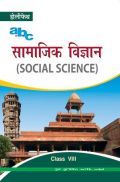This series of Sccial Science books for classes VI. VII and VIII is written as per the NCERT syllabus. These books atlempt to promote the understanding of history, geography and civics among the students. The series tries tosatiate the curiosity of the students,
The tools and techniques used for assessment, based on CCE, are interesting, relevant and meaningful and involve students for greater participation in studying. The series provides various chapter-related questions under different types of Assessments and topic wise activities/project work. based on CCE Scheme.
History section introduces the students to historical development from pre-historic era to present day. The chapters are arranged in a chronological order. This section includes events corroborated by inscriptions, aceounts by foreign travellers, court historians pictures, maps and records obtained from the archives. The special features are case studies for in-depth learning, timeline charts, historical maps ‘o locate places and routes taken by the voyagers, explorers and traders. Illustrations and photograph; of various events, rulers and buildings are a ysual treat to the studerts.
Geography section familiarises the students not only with thegeography of the country but also with the environment. It inculeates a posit-ve attitude and sensitivity in students towards the environ- ment. This section includes maps, thematic pictures, diagrams, data, etc.
Civics section introduces the students to political and social institutions of the country - The type of government, the ideals of the country, how the government i: formed and people responsible for it. The aim is to help students understand the meaning of diversity and constitutional values of the country. This section also contains illus:rations and flow diagrams.
This book Useful for Class VIII Students.
1. How, When and Where
2. The Company Establishes Power
3. Ruling the Countryside
4. Tribals, Dikus and the Vision of a Golden Age
5. The Revolt of 1857-1858
6. The Story of an Imperial Capital
7. Indian Crafts and Industries
8. System of Education under the British
9. Social Reform Movements
10. The Innovative World of Visual Arts
11. India Marches Towards Freedom
12. India After Independence
13. Resources
14. Land, Soil, Water, Natural Vegetation and Wildlife Resources
15. Mineral and Power Resources
16. Agriculture
17. Manufacturing Industries
18. Human Resources
19. The Constitution of India
20. Secularism: Fundamental Rights and Fundamental Duties
21. The Parliament in India
22. India: A Secular State
23. The Union Executive
24. Judiciary in India
25. Criminal Justice System
26. Confronting Marginalisation in India
27. Public Facilities
28. Enforcing Laws and Social Justice






























